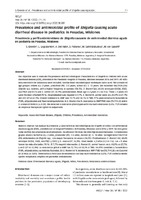Prevalence and antimicrobial profile of shigella causing acute diarrheal disease in pediatrics in Posadas, Misiones
Prevalencia y perfil antimicrobiano de shigella causante de enfermedad diarreica aguda en pediatría en Posadas, Misiones
Date
2022-10-31Author
Grenón, Sandra Liliana
Leguizamón, Lorena Beatriz
Del Valle, Ana Gabriela
Pallares, Sabrina
Salvi Grabulosa, Marcelo Ceferino
von Specht, Martha Helena
Metadata
Show full item recordAbstract
Our objective was to evaluate the presence and microbiological characteristics of
Shigella in children with acute diarrhoeal disease (ADD), attended at the Paediatric Hospital of Posadas, Misiones between 2016 and 2019. All ADEs documented in the laboratory were included. Standardised microbiological techniques were used. We considered age groups: infants (L)≤ 2 years, preschool (PE): 3-5 years, school (E): 5- 14 years. We recorded 106/2128 (5%) Shigella spp. isolates, with a higher frequency in summer (54.5%). S. flexneri (64; 60.4% serotypes 02(54), 03(3), AA479(2) and 01(1)) and S. sonnei (37; 34.9%) predominated. Mean age: 4.2 years (1.2 m-11a). Those < 5 years old were the most affected (70 %). Hospitalisation was required in 7.7%.
S. flexneri/S. sonnei were: in L (42.9% vs 27.7%) and in E (27 vs 42.9%). Overall resistance to AMP was 72.7% and 58.1% to TMS. 97% were sensitive to furazolidone (FUR), cefpodoxime and fluorinated quinolones. In S. flexneri the % resistance to AMP/TMS was (78.7/44.8) and in S. sonnei (61.8/80.6) p< 0.05). We detected 6 resistance phenotypes with low multi-resistance (2.6%). FUR remains an empirical therapeutic option in outpatients. Nuestro objetivo fue evaluar la presencia y características microbiológicas de
Shigella en niños con enfermedad diarreica aguda (EDA), atendidos en el Hospital Pediátrico de Posadas, Misiones entre 2016 y 2019. Se incluyeron todas las EDA documentadas en el laboratorio. Se utilizaron técnicas microbiológicas estandarizadas. Consideramos grupos etarios: lactantes (L)≤ 2 años, preescolar (PE): 3-5 años, escolar (E): 5- 14 años. Se registraron 106/2128 (5%) aislamientos de Shigella spp., con mayor frecuencia en verano (54,5%). Predominaron S. flexneri (64; 60,4% serotipos 02(54), 03(3), AA479(2) y 01(1)) y S. sonnei (37; 34,9%). Edad media: 4,2 años (1,2 m-11a). Los < 5 años fueron los más afectados (70 %). El 7,7% requirió internación. S. flexneri/S. sonnei fueron: en L (42,9% vs 27,7%) y en E (27 vs 42,9%). La resistencia global a AMP fue 72,7% y el 58,1% a TMS. Un 97% sensibles a furazolidona (FUR), cefpodoxima y quinolonas fluoradas. En S. flexneri el % resistencia a AMP/TMS fue (78,7/44,8) y en S.sonnei (61,8/80,6) p< 0,05). Detectamos 6 fenotipos de resistencia con baja multirresistencia (2,6%). FUR continúa siendo opción terapéutica empírica en pacientes ambulatorios.
Collections
The following license files are associated with this item:



